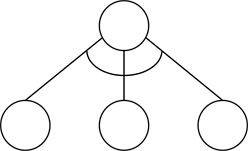1. 引言
近年来,国内外电力系统发生过多起连锁故障导致的大停电事故,造成了巨大的经济损失和灾难性后果 [1] [2] ,开展连锁故障预测研究对防御大停电事故、降低故障扩大风险、保障电力系统安全稳定运行具有重要意义。
针对连锁故障预测问题,近年来国内外学者进行了各种研究,提出了一些新理论和新方法。从总体上讲,现有的连锁故障预测方法可分为基于复杂系统理论和复杂网络理论的方法以及基于电力系统分析理论的方法。在基于复杂系统理论和复杂网络理论的方法范畴内,国内外学者提出连锁故障的OPA模型 [3] 、CASCADE模型 [4] 、小世界模型 [5] 等,这些方法主要从宏观角度分析连锁故障的发展机理,对电力系统物理特性的模拟均做了一定程度的简化。另一方面,基于电力系统分析理论的方法,利用确定性或概率性方法研究连锁故障的发生及发展,对连锁故障事故链的搜索尽量贴近故障发生的实际过程,比如文献 [6] 计及系统前后级故障的功率转移关系、保护/断路器不正确动作的可能性和系统硬件失效率等因素,提出了基于马尔科夫链的连锁故障预测方法。文献 [7] 提出基于事故链模型与模糊聚类算法预测连锁故障的发展模式,并运用动态故障树理论评估支路的重要度。
在电力企业风险管理中,一个微小的风险元,经过连锁反应即风险元的传递影响,可能会导致电力企业目标的巨大偏离,风险元传递理论的研究问题就是针对一些研究对象的风险变化引起目标对象的风险变化问题 [8] 。在连锁故障的演化过程中,各阶段中元件都因多种风险因素的影响而存在停运风险,而元件的停运又会导致与其关联性强的元件的停电风险增加,随着元件的依次停运,风险也会逐级传递,并促使系统进入临界状态,并最终导致连锁故障发生。可以看出,风险元传递理论可以描述连锁故障中风险因素风险变化对元件停运风险以及连锁故障风险的影响,找出受风险因素影响较大的风险传递路径,因此适用于连锁故障预测研究。
基于以上分析,本文将风险元传递理论应用到连锁故障的预测和评估,综合考虑了线路自身故障、潮流转移、隐性故障和天气等风险元对初始线路停运和后续线路停运的影响,建立了线路停运风险元传递模型;并根据线路停运与连锁故障发生的风险元传递结构,建立了连锁故障风险元传递模型。在此基础上,基于风险理论,建立了基于风险元传递的连锁故障预测和评估模型,预测连锁故障的发展路径,并计算连锁故障风险以及故障环节风险重要度。
2. 基于风险元传递的连锁故障传播分析
风险元传递针对的是一些研究对象的风险变化引起目标对象的风险变化。一般地,记论域为:
(1)
式中:xi表示风险研究对象,是一个不确定的值。
风险元传递定义:对于目标对象y,若存在着某种对应关系f,使得xi满足
,则称xi是影响目标对象y的风险元,对应关系f成为风险元传递函数。
在连锁故障过程中,线路自身故障、潮流转移、隐性故障和天气等因素都会导致线路发生停运,而线路的依次停运又会使系统发生连锁故障。可以看出,连锁故障中存在两种风险元传递过程,即线路停运风险元传递过程和连锁故障风险元传递过程。
风险元传递理论包含风险元、风险元度量方法和风险元传递结构,线路停运风险元传递过程具体如下:
1) 风险元和目标对象:风险元包含基于线路自身故障因素的线路停运,基于潮流转移的线路停运,基于隐性故障的线路停运和基于天气因素的线路停运,目标对象为初始线路停运和后续线路停运。
2) 风险元的度量方法:采用可能性度量方法,把风险视为不确定情况下各种结果出现的可能性,突出各种因素下的线路停运概率变化对初始线路停运概率和后续线路停运概率的影响。
3) 风险元传递结构:由于所有风险元同时作用于目标对象,即基于各种因素下的线路停运概率同时影响初始线路停运概率和后续线路停运概率,因此可采用与型传递结构,如图1所示。
假设每个风险元的表达方式为p(xi),则与行传递结构的基本传递方式为
(2)
同理,连锁故障风险元传递过程具体如下:
1) 风险元和目标对象:风险元包含初始线路停运和后续线路停运,目标对象为连锁故障发生。
2) 风险元的度量方法:采用可能性度量方法,突出线路停运概率变化对连锁故障发生概率的影响。
3) 风险元传递结构:由于所有风险元依次传递进行影响,即线路依次开断后才导致连锁故障发生,因此可采用串型传递结构,如图2所示。
假设每个风险元的表达方式为p(xi),则串行传递结构的基本传递方式为:
(3)

Figure 1. Serial structure of risk element
图1. 风险元的串行结构

Figure 2. Parallel structure of risk element
图2. 风险元的并行结构
3. 线路停运风险元传递过程
3.1. 各种因素下的线路停运概率
3.1.1. 基于线路自身故障因素的线路停运概率
线路自身故障因素主要考虑线路老化因素和线路检修因素。假设在相同的时间内电网处于同一地理环境,则线路的停运概率与线路的长度和单位长度故障率成正比 [9] 。本文假设线路的长度和单位长度故障率越大,线路停运概率越大,将所有线路长度与单位长度故障率乘积的归一化数值作为线路停运概率,则有:
(4)
式中:lom为线路m的单位长度老化故障率,lxm为线路m在检修后的单位长度故障率,Wm为线路m的长度,Line为系统中线路的集合。
3.1.2. 基于潮流转移的线路停运概率
潮流转移引起的线路停运概率取决于线路的负载率及该线路潮流变化对其他线路功率的影响 [6] 。
定义
为线路n的负载率,则有:
(5)
式中:Fn为线路n开断前的潮流值,Fmax,n为线路n的潮流极限值。
线路潮流变化对其他线路功率的影响可以用线路潮流波动指标、线路负载率指标和线路耦合指标来决定。
线路潮流波动指标Anm表示线路n切除后线路m的潮流变化量与线路m原有潮流的比值,该指标越大,则线路潮流波动越大,有:
(6)
式中:Fm为线路n开断前线路m的潮流值,
为线路n开断后线路m的潮流值
线路负载率指标Hnm表示线路n切除后线路m负载率,有:
(7)
线路耦合指标Bnm表示线路n切除后线路m的潮流变化量与线路n原有潮流的比值,该指标越大,说明线路n退出对线路m的潮流变化影响越大,有:
(8)
设定前后级线路故障的关联度指标Dnm为:
(9)
假设当前非故障线路与前一级故障线路的关联程度越大,其停运概率也越大 [6] ,则线路n开断后,潮流转移引起的线路m的停运概率可表示为:
(10)
3.1.3. 基于隐性故障的线路停运概率
隐性故障作为保护装置中存在的一种固有缺陷,只有当系统发生故障时这种缺陷才会表现出来,从而导致被保护元件的不恰当断开 [10] 。当线路开断后全网潮流重新分配的过程中,可能会发生因保护或断路器误动引起的线路停运。由于单重隐性故障的概率已经很小,多重隐性故障的概率就更小了,因此本文不考虑多重隐性故障,则隐性故障引起的线路m的停运概率可表示为:
(11)
式中:pmis_b为保护误动概率,pmis_d为断路器误动概率。
针对保护误动的情况,本文以距离保护为例,并假设距离保护为全阻抗保护,设Zset为整定阻抗,Zk为测量阻抗。根据全阻抗保护的动作特性,圆轨迹将阻抗复平面分为圆内和圆外两部分,分别对应着动作区和不动作区,而圆轨迹上处于动作的临界状态。假设保护误动概率在圆内误动概率为0,在圆周处误动概率最大,在圆外误动概率随着测量阻抗的增大而线性减小 [11] ,且当测量阻抗增加到3Zset时误动概率减小为0 [12] ,因此保护误动的概率可表示为:
(12)
式中:pZ为保护最大误动概率。
断路器误动概率与断路器物理特性有关,可视为常数。
3.1.4. 基于天气因素的线路停运概率
在实际电网中运行的输电线路是暴露在室外的,其故障率与所处的天气情况有关。在雷雨、台风、冰雪等一些极度恶劣的天气条件下,线路的故障率大大增加 [13] 。为简化起见,本文采用文献 [13] 使用的两状态天气模型来描述输电线路的偶然失效故障率。
由于长距离输电线路可能跨越多个气候区域,同一条线路在同一时刻可能处于不同的天气状况,则在两状态天气模型下,线路在第i个气候区域内单位长度的偶然失效故障率lti可表示为:
(13)
式中:e为线路在恶劣天气下的故障比例,N1为正常天气持续时间比例,N2为恶劣天气持续时间比例,
为线路单位长度故障率的统计平均值,zi表示线路所处的气候区域i的天气状况,其中
表示正常天气,
表示恶劣天气。
线路总的偶然失效故障率lt为:
(14)
式中:I为线路经过的气候区域数,li为线路在第i个气候区域的长度。
如果在短时间t内天气状况保持不变,那么线路故障率也不变,可认为运行时间服从指数分布 [13] 。因此本文假设短时间t内天气状况保持不变,则线路单独停运概率为:
(15)
3.2. 线路停运的风险传递函数
3.2.1. 初始线路停运的风险传递函数
初始线路停运概率主要考虑线路自身故障因素x1和天气因素x4的影响,根据式(2)可知,线路m的初始线路停运概率p1m为:
(16)
3.2.2. 后续线路停运的风险传递函数
1) 当线路m严重过载时,即线路m的潮流超过其极限值,第j-1次故障后线路m的停运概率为过负荷保护不拒动且断路器不拒动的概率,即有:
(17)
式中:pinact_b为保护拒动概率,pinact_d为断路器拒动概率。
2) 当无线路严重过载时,线路随机故障、保护隐性故障成为推动连锁故障发展的主要因素,天气因素起到了加剧故障发生概率的作用。因此第j-1次故障后线路m的停运概率主要考虑潮流转移x2、隐性故障x3和天气因素x4的影响,根据式(2),即有:
(18)
4. 连锁故障风险元传递过程及风险评估
4.1. 连锁故障的风险传递函数
假设电网具有u个连锁故障路径,则连锁故障路径集合和连锁故障路径可表示为:
(19)
(20)
式中:Tij为第i条连锁故障路径的第j个故障环节,
。
以连锁故障路径L1为例,该故障路径有v条线路相继开断,则根据式(3),该故障路径的发生概率pL1为:
(21)
式中:p1为初始线路停运概率,
为前j-1次故障发生后的条件下的第j个后续线路停运的概率,初始线路停运概率和后续线路停运概率计算见3.2节。
4.2. 连锁故障后果和风险计算
本文从负荷产生的经济损失的角度计算连锁故障L1在第j个故障环节产生的后果SL1j [14] 。其中S1j主要考虑3个方面:连锁故障L1第j个故障环节引起系统解列造成的负荷经济损失;连锁故障L1第j个故障环节引起的线路过载造成的负荷经济损失;连锁故障L1第j个故障环节引起的暂态失稳造成的负荷经济损失。为了简化问题难度,当系统解列后形成孤网时,如果孤网中发电容量大于负荷,则认为孤网能够就地平衡,如果孤网中发电容量小于负荷,则将负荷和发电机出力的差值近似为失负荷量;当线路过载时,采用文献 [15] 中的计算方法,求取消除线路过载所需的切机切负荷量,并将所切负荷量作为线路过载造成的失负荷量;当系统暂态失稳时,采用文献 [16] 中的暂态稳定控制方法,求取使系统恢复稳定的切机切负荷量,并将所切负荷量作为暂态失稳造成的失负荷量。
连锁故障L1第j个故障环节的后果为:
(22)
式中:M为停电负荷的单位成本,VL1j为连锁故障L1在第j个故障环节发生后系统的失负荷量。
将已发生故障环节的概率与故障环节后果的乘积作为已发生故障环节的风险,可得到连锁故障L1前j个故障环节的停电风险:
(23)
需要说明的是,当j等于v,即已发生故障环节的最后一个故障环节为连锁故障路径的最后一个故障环节时,连锁故障L1前j个故障环节的停电风险等于连锁故障L1的停电风险RL1。
4.3. 故障环节的风险重要度计算
由于同一条连锁故障路径中的不同故障环节在连锁故障路径中的重要度不同,因此定义故障环节的风险重要度来表示同一条连锁故障路径中的故障环节对连锁故障路径的重要程度,其表达式为:
(24)
式中:RLij为连锁故障路径Li的前j个环节的停电风险,
为连锁故障路径Li的前j-1个环节的停电风险,RLi为连锁故障路径Li的停电风险。
αij值越大,则故障环节Tij对连锁故障路径Li的重要度越高,对Li的风险的影响越大。
5. 基于风险元传递的连锁故障预测流程
综上所述,所提出的基于风险元传递的连锁故障预测模型的流程如图3所示。
从图3中可知,在上一级线路切除后,可计算剩余线路停运概率;为了减少后续仿真的工作量,同时兼顾预测到相对更多的连锁故障演化模式,采用加权模糊C均值聚类算法(weighted fuzzy C-means, WFCM)对线路停运概率值进行聚类 [17] ;通过聚类,从线路停运概率值最高的一类线路中选取下一级开断线路,得到各自的连锁故障路径。此外,图中判断一次预测是否结束的结束条件包括3个判据:1) 如果多次开断导致系统失去暂态稳定,停止预测;2) 当系统发生解列时停止预测;3) 达到最大预测深度D,即预测深度j大于等于D,停止预测。
6. 算例分析
6.1. 算例
根据文献 [7] 的方法,可得到初始停运线路集合,对应的初始线路停运概率可根据式(16)求取,如表1所示。
6.2. 连锁故障预测及风险评估
根据图3的预测流程,可得到连锁故障路径集合,其中部分连锁故障路径如表2所示。
表1. 初始故障集合

Table 2. Part of cascading failure chains
表2. 部分连锁故障路径
以线路30为初始故障的连锁故障发展路径为例,通过式(21)、(22)和(23),求取故障环节发生概率、后果和风险,具体如表3所示。
由此得出在线路30发生故障并退出运行后,{L32}和{L31、L33}成为可能性最大的2条连锁故障路径。同时表3列出了不同故障路径在各故障环节对应的概率、后果和风险,可作为辅助数据,以利于运行人员对可能发生的连锁故障在整体上进行把握。
6.3. 故障环节的风险重要度计算
根据式(23)计算出各连锁故障路径的停电风险,将表2中部分连锁故障路径的停电风险如表4所示。
根据表4中各连锁故障路径的停电风险,按式(24)计算出连锁故障路径中各故障环节的风险重要度,如表5所示。
以连锁故障路径L1为例说明故障环节风险重要度的变化情况。在线路10 (故障环节1)开断后,其承担的功率在其输电断面内发生转移,导致线路40、41潮流增加,此时若线路41 (故障环节2)发生开断,发电机会通过线路31、32、33、34、35补充负荷8所缺失的功率,从而引起线路33、35过载,当线路33 (故障环节3)发生开断后,系统将发生大面积解列,导致大停电发生。根据上述分析,线路41开断后系统出现过载线路,因此连锁故障路径{10、41}出现了停电风险;而当线路33开断后,虽然连锁故障路径{10、41、33}的发生概率要小于{10、41},但线路33开断后会导致系统大面积解列,并伴随线路过载,其后果会显著增加,所以其风险也远大于连锁故障路径{10、41}的风险。因此从表5可以看出,线路33对连锁故障路径L1的风险影响最大,而线路10对连锁故障路径L1的风险影响最小。通过求取故障环节的风险重要度,可以帮助运行人员了解连锁故障路径中的脆弱环节,以便于选取最佳控制方案阻断连锁故障。

Table 3. Forecasting chains after branch 18 outage
表3. 线路18开断后的预测路径表

Table 4. Blackout risk of part cascading failure chains
表4. 部分连锁故障路径的停电风险

Table 5. Risk importance distribution of cascading failure links
表5. 连锁故障环节风险重要度
7. 结论
本文将风险元传递理论应用于连锁故障预测和评估,建立了基于风险元传递的连锁故障预测和评估模型。综合考虑了线路自身故障、潮流转移、隐性故障和天气等风险元对初始线路停运和后续线路停运的影响,建立了线路停运风险元传递模型;根据线路停运与连锁故障发生的风险元传递结构,建立了连锁故障风险元传递模型,帮助调度调度人员了解当前运行工况下最需关注的故障发展方向。基于风险理论,对连锁故障进行风险评估,计算故障环节风险重要度,帮助运行人员了解连锁故障路径中的脆弱环节,以便于选取最佳控制方案阻断连锁故障。
基金项目
国家高技术研究发展计划(863计划)资助项目(2015AA050104)。